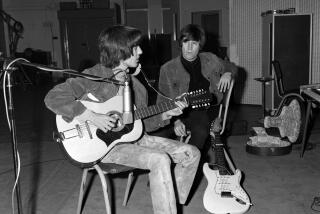Stradivari surprise: Soloists diss famous violins in blind tests
What makes old violins crafted by members of the Stradivari family so much better than violins produced today? Nothing, according to a new study in the Proceedings of the National Academy of Sciences.
In a musical version of the classic Coke versus Pepsi taste tests, scientists teamed up with experts who make, play and sell violins to see whether there’s any substance to the widespread belief that old violins are superior to newer models. Just as with soda, the researchers discovered that highly accomplished violin soloists couldn’t tell the difference between old and new instruments. What’s more, when the soloists didn’t know the ages of the instruments they were playing, they gave higher marks to the new violins than the ones made centuries ago by Italian masters.
The elaborate study builds on an experiment conducted in 2010 at the International Violin Competition of Indianapolis. Four years ago, researchers invited 21 violinists to play three old violins – including two made by Stradivari – and three new instruments. Surprisingly, the violinists couldn’t tell which instruments were new and which were old. The favorite violin turned out to be a new model, and the least favorite was a Stradivari.
Since those results were reported (also in the journal PNAS), people have looked for reasons to explain the poor showing of the old violins. Among the critiques: the test included only six instruments; the instruments were evaluated in a hotel room; and each player had less than 30 minutes to make their assessments.
This time around, the researchers selected six old violins (including five made by Stradivari) to go up against six new ones. They invited 10 highly accomplished soloists to put the instruments through their paces and select the one they’d most like to take on tour with them. Compared to the Indianapolis test, they also gave the musicians more time to assess the instruments (a total of 2.5 hours) and had them play in both a rehearsal room and a 300-seat concert hall.
The researchers went to great lengths to prevent the soloists from guessing the age of the violins based on their appearance, feel, scent or other factors. New instruments were “antiqued” so that hard edges would not give them away. Musicians were asked to wear tinted goggles and play in darkened rooms.
At the end of the sessions, players evaluated the violins based on their overall quality as well as specific factors like playability, tone quality and clarity. They ranked their top four instruments and were allowed to reject any they found unsuitable. Each violin earned four points for a first-place vote, three points for a second-place vote, two for third and one for fourth. Each rejection cost a violin a point.
After all the testing, a clear winner emerged – a new violin known a “N5.” Four of the 10 soloists picked it as their favorite, four ranked it second and it was rejected only twice. That translated into a score of 26 points.
Coming in second with 13 points was “N10,” another new violin. Then came “O1,” a Golden Period Stradivari that garnered 11 points.
At the other end of the spectrum was “O12,” a Stradivari that was rejected nine times and thus earned a final score of -9.
The researchers tried some alternate scoring systems to see if the old violins would fare any better. But even when they focused only on soloists’ favorites or ignored rejections, the new violins still came out on top. “We can find no plausible scoring system by which the old fare any better,” the researchers wrote.
The investigators also asked the soloists to play several violins for 30 seconds each and then guess whether they were new or old. Out of 69 total guesses, 33 were wrong and 31 were right. (Another five guesses were “indeterminate,” the researchers reported.)
The soloists did an even worse job of guessing the age of the violins they liked best. When the researchers restricted their analysis to the violins that got top-four ratings, the soloists guessed that the instruments were old in 14 cases and new in seven cases. In fact, the violins were old in nine cases and new in 12 cases. If a soloist likes a violin, he or she will be inclined to think it’s old, the researchers said.
“It is clear that, among these players (seven of whom regularly play old Italian violins) and these instruments (five of which were made by Stradivari), there is an overall preference for the new,” the researchers concluded. “Given the stature and experience of our soloists, continuing claims for the existence of playing qualities unique to old Italian violins are strongly in need of empirical support.”
If science is music to your ears, you like the things I write about. Follow me on Twitter and “like” Los Angeles Times Science & Health on Facebook.







